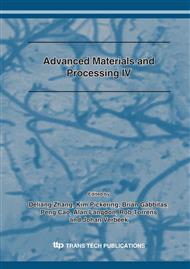p.275
p.279
p.283
p.287
p.291
p.295
p.299
p.303
p.307
MWNT Polymer Nanocomposites Based on P3HT
Abstract:
Thin and short multi walled carbon nanotubes (MWNTs) were used to prepare nanocomposites based on poly(3-hexylthiophene) (P3HT). The MWNTs were characterized by TEG, SEM, TEM and Raman spectroscopy following deposition of films from stable dispersions of MWNT in chloroform. Non-covalent interaction between MWNT and P3HT dissolved in chloroform allowed the preparation of solution-cast composite films. Composite thermal events such as glass transition, melting temperature and heat of fusion were investigated by DSC and compared with pure polymer. Conductivity of composite bulk films was measured as a function of temperature by 2-point probe DC-resistance measurements. Loadings of MWNTs above 0.1 weight percent (wt%) in the conjugated polymer significantly increased the conductivity of P3HT composites. Interplay between charge transport through the semiconductor polymer and carbon nanotube network allowed the increase of conductivity after percolation to values close to 10-2 S cm-1, an improvement of four orders of magnitude over that of films cast from pure P3HT.
Info:
Periodical:
Pages:
291-294
Citation:
Online since:
November 2007
Authors:
Price:
Сopyright:
© 2007 Trans Tech Publications Ltd. All Rights Reserved
Share:
Citation:


